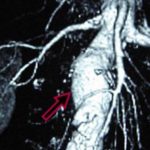1. A clinical score used to estimate the diameter of the ascending aorta was developed and validated using retrospective data from asymptomatic patients in the United Kingdom.
2. Validation of this initial model demonstrated low sensitivity but high specificity.
Level of Evidence Rating: 2 (Good)
Study Rundown: Aneurysms of the ascending thoracic aorta are susceptible to rupture or dissection and can lead to significant hemodynamic instability and death. Many individuals with thoracic aortic aneurysms are asymptomatic at baseline, and their pathology is detected incidentally on imaging or acutely at the time of disease complications. Early detection of aortic aneurysm is important, as medical and surgical options are available to decrease the incidence of rupture or dissection in some patients. The present study sought to develop and validate a model to predict ascending aorta diameter in asymptomatic individuals.
In total, 36,699 participants were included in prediction score development, of which 30,018 individuals contributed to the model training and 6681 to the internal validation phase using MRI comparison. Data from 52,135 individuals were used for external validation. Overall, the prevalence of thoracic aortic enlargement to 4 cm or greater was 2.3% amongst the internal cohort and 5.3% amongst the external validation cohort. The correlation coefficient between the AORTA score and the actual aortic diameter on internal validation was 0.53. The correlation coefficient between the AORTA score and the actual aortic diameter on external validation was 0.56. The score tended to underestimate the size of enlarged aortas. The sensitivity to detect an aorta size of 4 cm or greater ranged between 8.9-18.8% with a specificity of 96.2-99.2%.
The present study by Pirruccello et al. established a prediction model based on common demographic and clinical characteristics to estimate thoracic aortic diameter. This model, the AORTA score, subsequently underwent validity testing and was found to correlate moderately with actual size measurements, although it did underestimate the size of enlarged aortas. Strengths of this study include the large population size and thoroughness of statistical analysis. A primary limitation of this work was the limited data available which makes it difficult to account for all factors involved in determining aortic size (i.e., diet & lifestyle, genetics) and may account for inaccuracies in the model. Future studies should look to address these shortcomings to improve the accuracy of the AORTA score’s predictive value.
Click here to read this study in JAMA
Relevant reading: Systematic review of circulating, biomechanical, and genetic markers for the prediction of abdominal aortic aneurysm growth and rupture
In-Depth [retrospective cohort]: Study data were derived from a repository of ambulatory patients in the United Kingdom with no clinical suspicion of an ascending aortic aneurysm who underwent magnetic resonance imaging (MRI) of the thorax for aortic measurement. Patients aged 40-69 years in the United Kingdom were recruited on a voluntary basis. The prediction score developed was termed AORTA, or aorta optimized regression for thoracic aneurysm, score. Computed tomography (CT) aortic measurements from the Framingham Risk Index study population and transthoracic echocardiography (TTE) aortic measurements from the Mass General Brigham Biobank were used for external validation. The primary outcome was the correlation between the actual size of the thoracic aorta on imaging and the predicted size using the AORTA score.
On internal validation, AORTA score correlated moderately well with actual aortic size (r = 0.53, 95% confidence interval 0.52-0.55). The corresponding mean actual percent error was 7.4% (7.3-7.5%). In the external validation phase, compared to the Framingham Risk Score study population, the correlation coefficient was 0.56 (0.52-0.59), which was still moderate in the strength of correlation. The associated mean actual percent error was higher at 10.2% (9.9-10.6%). Finally, external validation using the Mass General TTE dataset yielded a moderate correlation coefficient of 0.57 (0.56-0.58) and an associated mean error of 9.1% (9.0-9.1%). A standard deviation of 0.6 was found to explain variance in aortic aneurysm measurement on MRI versus CT imaging modalities.
Finally, the prevalence of aortic aneurysms measuring 4 cm or greater in diameter amongst the UK MRI cohort was compared with the estimates from the AORTA score. By this measure, 2.3% of the cohort had an enlarged aorta, whereas the top 2.3% of aortic measurements identified through the AORTA score yielded a mean of 3.537 cm. This finding was consistent with the previously noted tendency of the AORTA score to underestimate enlarged aortic size. The sensitivity to detect an aorta size of 4 cm or greater ranged between 8.9-18.8% with a specificity of 96.2-99.2%.
Image: PD
©2022 2 Minute Medicine, Inc. All rights reserved. No works may be reproduced without expressed written consent from 2 Minute Medicine, Inc. Inquire about licensing here. No article should be construed as medical advice and is not intended as such by the authors or by 2 Minute Medicine, Inc.


